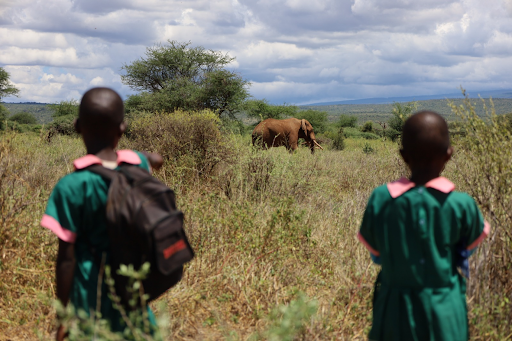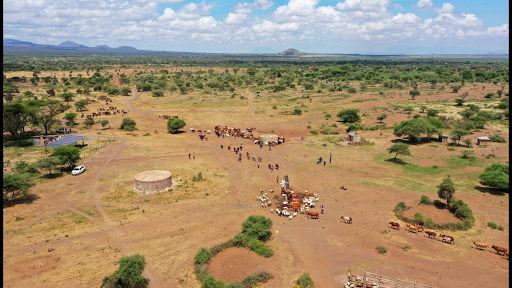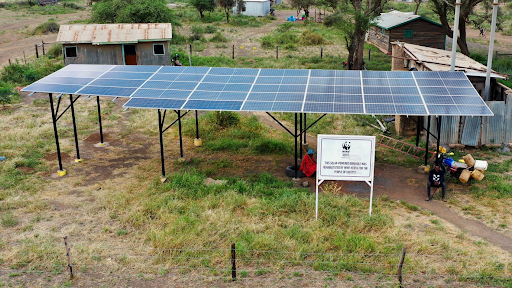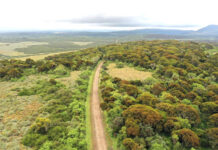
By Liz Anyango
Ilmarba, Kajiado County: Days before schools closed for the April holiday in Kenya, we met two school-going children on the side of a winding footpath in Ilmarba, Kajiado County. Their curious gaze fixates on a solitary elephant, meters away from where they are standing.
The encounter sparks a flurry of questions between the two girls, who appear to be barely ten years old. “Why is this elephant wandering alone? Where could its family be hiding within the dense thicket?” With eyes darting in search of answers, they share their knowledge of elephants.
They inform us that they are aware that most elephants have strong, close-knit family bonds, move in family herds, and that lone sightings are rare in these gentle giants. Therefore, they suspect there could be more in the thicket.
This encounter sheds light on the daily realities faced by schoolchildren in Ilmarba, a settlement adjacent to the Amboseli National Park. The journey to and from school for the young ones is fraught with unpredictability as they navigate the dangerous journey in search of education.
In Kenya, over 60% of wildlife is outside protected areas, in community and individual land, where Human-Wildlife Conflict cases are prevalent. People interact daily with wildlife in the only place they call home.
Ngorongoro village inside Ilmarba is surrounded by several schools, and settlements, estimated to be a stone’s throw away from the Amboseli National Park, it has been plagued by conflict for years.
Joshua Mutengere, a resident, points out that scarcity of water is the primary catalyst for the conflict. He explains, “Our main challenge was the lack of enough water for our cattle and families. We used to go inside the park with our cattle for water, but lions would kill our cattle.”

Despite the longstanding challenges posed by human-wildlife conflict, a success story of a sustainable solution has been found within the same community.
As you enter the village, the first sight that greets you is a solar-powered borehole brimming with life. Cattle and goats drink water peacefully. In the distance, a water trough, specifically for wild animals, is visible. Women fill their jerrycans with a separate, fenced structure, showcasing an intervention designed for harmonious co-existence.
Nelson Sinaiyo, the chairman of the Community water project, recalls the hardships endured prior to the installation of the solar-powered system. “We had a borehole drilled in the 80s, but it was powered by fuel. We needed a generator, which ran on diesel, and community members had to contribute money. We would walk for about 50 km to buy the fuel.”
Sinaiyo adds that previously, they spent more to maintain the generator. The pastoral community paid Ksh 100 per cow and Ksh 20 per goat monthly for the purchase of fuel and maintenance of the borehole.
With the borehole now solarized, they now pay Ksh 30 per cow and Ksh 5 per goat per month for the borehole maintenance. An impressive 70% and 83% reduction respectively. With the subsidized amount, the community now invests the money in other income-generating activities while appreciating the reduced financial burden.
“Before we got this solar system, I used to pay 100 shillings for each cow per month. But after getting the solar system, the cost has been reduced, and now I only pay 30 shillings. That totals to 1,500 shillings compared to the previous amount of 5,000 shillings,” adds Jackson Leposo, a resident.
“Now there are approximately 5,000 cattle from the Maraba community. There are about 7,000 goats, and now they have access to water. We have around 500 households using this borehole,” Sinaiyo highlighted.
The positive impact of the solar-powered borehole extends beyond domestic use to encompass educational institutions such as the Olmoti Day and Boarding Comprehensive School.
Dominic Kyalo, a senior teacher at the institution, explains that the School has seen a remarkable increase in enrollment. “Previously, our water tank was damaged by elephants, leading to water scarcity, and children, especially the young ones, were missing school,” he adds “However, with the solar-powered borehole, we have seen an increase from 250 to 600 students.”
Kyalo also happily informs us that the school has even embarked on a thriving tree nursery project.

The solar-powered borehole is a joint effort involving the World Wide Fund for Nature – Kenya (WWF – Kenya), Kenya Wildlife Service (KWS), and the community, as explained by Dr. John Kioko WWF-Kenya’s Programme Coordinator, Amboseli-Chyulu Sub-landscape, “We wanted to prevent the human-wildlife conflict by promoting coexistence. The only water found in this area is in the park so WWF together with funding from the German Federal Ministry of Economic Cooperation and Development – BMZ decided to enhance water provision for the community in this area. The water is used for livestock, by the community, and by wildlife.”
Kioko added “This project cost about 3.5 million Kenya Shillings and it is not only cost-effective to maintain but also environmentally friendly. It is a community-led project, whereby WWF-Kenya and Kenya Wildlife Service (KWS) are partnering with the community. So the community runs the project through a committee whereby they collect funds for maintenance.”
The Amboseli ecosystem, spanning 5,000 square kilometers, has limited water sources, especially in the dryer semi-arid areas. Providing water beyond park boundaries is therefore crucial.
The solar-powered borehole has become a lifeline, eliminating the struggle for survival and fostering a future of shared coexistence and prosperity between humans and wildlife in Ilmarba.













